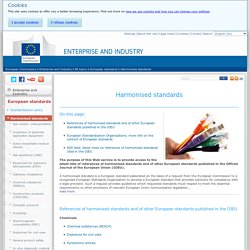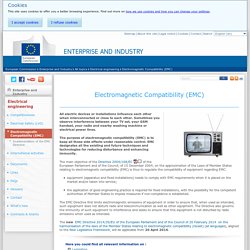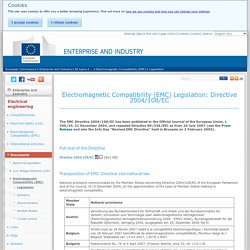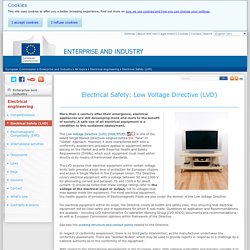

Harmonised standards - European standards - Enterprise and Industry. A harmonised standard is a European standard elaborated on the basis of a request from the European Commission to a recognised European Standards Organisation to develop a European standard that provides solutions for compliance with a legal provision.

Such a request provides guidelines which requested standards must respect to meet the essential requirements or other provisions of relevant European Union harmonisation legislation... Compliance with harmonised standards provides a presumption of conformity with the corresponding requirements of harmonisation legislation. Manufacturers, other economic operators or conformity assessment bodies can use harmonised standards to demonstrate that products, services or processes comply with relevant EU legislation.
To create the capacity to confer this presumption of conformity, the references of harmonised standards must be published in the Official Journal of the European Union. The use of these standards remains voluntary. Electromagnetic Compatibility (EMC) - Electrical engineering - Enterprise and Industry. All electric devices or installations influence each other when interconnected or close to each other.

Sometimes you observe interference between your TV set, your GSM handset, your radio and nearby washing machine or electrical power lines. The purpose of electromagnetic compatibility (EMC) is to keep all those side effects under reasonable control. EMC designates all the existing and future techniques and technologies for reducing disturbance and enhancing immunity. The main objective of the Directive 2004/108/EC of the European Parliament and of the Council, of 15 December 2004, on the approximation of the Laws of Member States relating to electromagnetic compatibility (EMC) is thus to regulate the compatibility of equipment regarding EMC: The EMC Directive first limits electromagnetic emissions of equipment in order to ensure that, when used as intended, such equipment does not disturb radio and telecommunication as well as other equipment.
Electromagnetic Compatibility (EMC) - Guidance - Electrical engineering - Enterprise and Industry. Electromagnetic Compatibility (EMC) Legislation: Directive 2004/108/EC - Electrical engineering - Enterprise and Industry. Zákon České národní rady č. 64/1986 Sb., o České obchodní inspekci, Sbirka Zakonu České Republiky 03/11/1986.

Zákon České národní rady č. 240/1992 Sb., kterým se mění a doplňuje zákon České národní rady č. 64/1986 Sb., o České obchodní inspekci. Zákon č. 22/1997 Sb., o technických požadavcích na výrobky a o změně a doplnění některých zákonů, Sbírka zákonů České Republiky, částka 6/1997, str. 128. Zákon č. 71/2000 Sb., kterým se mění zákon č. 22/1997 Sb., o technických požadavcích na výrobky a o změně a doplnění některých zákonů, a některé další zákony, Sbírka Zákonů České Republiky, částka 24/2000, str. 1314. Nařízení vlády č. 291/2000 Sb., kterým se stanoví grafická podoba označení CE, Sbirka Zakonu Sbirka Zakonu České Republiky 29/08/2000. Zákon č. 205/2002 Sb., kterým se mění zákon č. 22/1997 Sb., o technických požadavcích na výrobky a o změně a doplnění některých zákonů, ve znění pozdějších předpisů, a některé další zákony, Sbírka Zákonů České Republiky, částka 82/2002, str. 4861.
Electrical Safety: Low Voltage Directive (LVD) - Electrical engineering - Enterprise and Industry. More than a century after their emergence, electrical appliances are still developing more and more to the benefit of society.

A safe use of all electrical equipment is a condition to this sustained deployment. The Low Voltage Directive (LVD) 2006/95/EC is one of the oldest Single Market Directives adopted before the "New" or "Global" Approach. However, it does characterise both with a conformity assessment procedure applied to equipment before placing on the Market and with Essential Health and Safety Requirements (EHSRs) which such equipment must meet either directly or by means of harmonised standards. The LVD ensures that electrical equipment within certain voltage limits both provides a high level of protection for European citizens and enjoys a Single Market in the European Union. For electrical equipment within its scope, the Directive covers all health and safety risks, thus ensuring that electrical equipment will be used safely and in applications for which it was made.